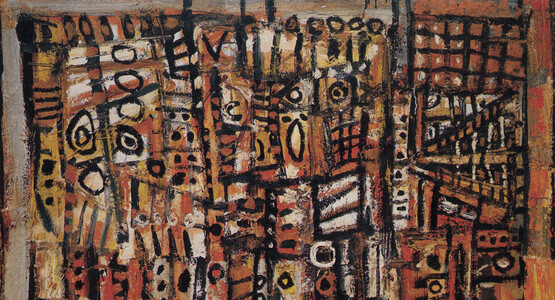Dialectics and transgressions: Robert Smithson’s cartouche drawings
by Teresa Hantke • June 2023. In collaboration with Drawing Room, London • Journal article
Provocative and lascivious bare-breasted women sprawl in psychedelic mixtures of colour; nude bikers with feathered wings ride Harley-Davidsons; and muscular Adonises in skimpy leather clothing pose in front of flashes of coloured crystal. Reminiscent of scenes from a low-budget film, these images in fact belong to a series of Pop art drawings and collages by the American sculptor and Land artist Robert Smithson (1938–73), which he created between 1963 and 1964. In these figurative works – described by Smithson in a 1972 interview with the art historian Paul Cummings as ‘cartouches’ that were ‘sort of proto-psychedelic’ – beefcake meets Mannerism.1
Here, Smithson contrasts Classical iconography with contemporary pop culture subjects. In Untitled FIG. 1, for example, an ‘electrified’ Venus pudica flirts with a nude, winged man in ankle boots. It is an unfolding of and experimentation with colour, form, content and material: a mixing and contrasting of styles and media. With their juxtaposition of ‘highbrow’ and ‘lowbrow’ elements, these works testify not only to the artist’s enthusiasm for pop culture and natural science, but also to his interest in Mannerist art. In 1972 Smithson claimed that he was in a phase of artistic transition around the time that the cartouches were created:
I would say that I began to function as a conscious artist around 1964–1965. [...] prior to [this...] I was in a kind of groping, investigating period. [...] That’s when I consider my emergence as a conscious artist. Prior to that my struggle was to get into another realm.2
Under a veil of Pop art and porn, the compositions and motifs undoubtedly prefigure Smithson’s later work. Thus, should they truly be assigned only to a ‘groping, investigating period’ as Smithson himself claims? To what extent did the artist use his 1972 self-stylisation as a ‘conscious artist’ to degrade these cartouches, which indicate a visual interest in homoerotic representations. Although he describes works made during this period as ‘immature’, they nonetheless evidence the emergence of his interest in dialectics and dualisms. In a 1972 interview with the Italian architect Gianni Pettena, Smithson emphasised his preoccupation with the dialectic of the centre and periphery, which is an essential facet of his artistic activity: ‘It’s kind of interesting to bring the fringes into the centrality and the centrality out to the fringes’.3 In assessing Smithson’s cartouches, it becomes evident that this dialectic – which came to define his later work, with its tension between ‘site’ and ‘non-site’ – had already manifested itself in his early work. Even before 1964, Smithson was fascinated by the question of boundaries and the relationship between the peripheral the central. Several times in his essays he quoted the French philosopher and mathematician Blaise Pascal: ‘Nature is an infinite sphere, whose centre is everywhere and whose circumference is nowhere’.4 In the cartouches, this dualism is not only evident on a pictorial and spatial level, but also, particularly, on a conceptual level.
Smithson is primarily known for his earthworks, most notably Spiral Jetty (1970) and not, for example, his drawings of a Giorgione Venus in a neon cloak FIG. 2. One reason for this is that Smithson withheld the works from public view. As Eugenie Tsai notes: ‘Smithson regarded the cartouche drawings [...] of diaristic nature. They were left in a drawer [...] and were rarely shown even to fellow artists’.5 This may be due to their homoerotic motifs, but also perhaps a result of the artist’s decision to deliberately separate his pre-1964 works from his phase as a ‘conscious artist’. As a Land artist and a conceptual artist, he aimed to break away from the painting and figurative representations that dominated his early work.
By describing his Pop art drawings as cartouches, Smithson skilfully elevated his drawings to the genre of elaborate framing devices that became an integral ornamental feature from the sixteenth century onwards. Used for anything from coats of arms to portraits or genre and landscape paintings, they were characterised by a duality between a blank centre and a richly decorated frame, creating a counterplay between the solidified and the moving, the exalted and the absurd. Similarly, Smithson’s cartouches include a central geometric element around which a dominant, decorated frame is placed, reversing the traditional compositional hierarchy of centrally positioned figures surrounded by a subordinate frame. He pushes the narrative from the centre to the edge; this is where the action takes place.
In this way, Smithson allows his interests, most notably his impressions of New York – which the artist referred to as a ‘big sprawling nightmare centre’ – to speak from the frames.6 By filling in the margins and shifting the action to the periphery, he makes clear the ambivalence between the edge and the central image. In particular, through this decentralisation, Smithson took up the motif of the arabesque, an ‘infinitely repeatable floral ornament [...] of non-objective, linear scrolls’,7 and the grotesque, ‘a fantastic mixed ornament with figural, vegetable, architectural and landscape components’, to illustrate the tension between the centre and periphery.8
Thinking in opposites determined Smithson’s work: ‘Dialectics is not only the ideational formula of thesis-antithesis-synthesis forever sealed in the mind, but an ongoing development’.9 Thus, such concepts – movement and standstill, centre and edge, flowing and crystalline forms – are evident in much of his late work. Even if the years 1964–65 represent an important turning point for Smithson, in which he apparently freed himself from figuration, from the ‘tramps and madmen’10 that appear in his Pop art cartoons – ‘I got that out of my system, you might say’ – conceptual relics of this early work can certainly be recognised in his later work, such as Mono Lake Nonsite (Cinders Near Black Point) FIG. 3.11
The origins of the cartouches, at least in terms of compositional design, may have stemmed from the art of Mannerism. In his 1966 essay ‘Abstract Mannerism’, Smithson described ‘great Mannerism’ as ‘the ultra-consciousness of the framing edge’.12 He quotes Jacques Bousquet’s book on Mannerism, which was published in the early 1960s: ‘By a typically Mannerist paradox, the frame became the picture. In France, the feigned frame enjoyed great vogue’.13 Bousquet emphasised the influence of the Fontainebleau School, which produced Mannerist paintings and decorative sculpture for the French court under the patronage of Francis I (reg.1515–47):
One of the most beautiful painted frames of the French school was created by Jean Dubois [...] They consist of a myriad of strange details, yet do not seem overloaded. For a time the style of the painted frames of Fontainebleau is to be found throughout Europe; in Rottenhammer’s Venus and Minerva in Amsterdam, for example, their influence is unmistakable.14
Smithson, reading Bousquet’s text, may have seen the black-and-white reproduction of Venus and Minerva FIG. 4, which the author attributed to Hans Rottenhammer but has since been attributed to Pellegrino Tibaldi, as well as the image of the Nymph of Fontainebleau FIG. 5, a cartouche by the Italian painter Rosso Fiorentino that formed part of a larger decorative scheme commissioned by Francis I for château de Fontainebleau (1534–1540/41). Both works feature elaborately decorated frames that contrast with their comparatively simple centres. Tibaldi’s cartouche in particular not only creates a contrast between the centre and the edges, but at the same time testifies to a pictorial unity that also underlies Smithson’s cartouches. A closer look at Tibaldi’s painting reveals a number of similarities with the designs in Smithson’s Pop art frames. For example, in the upper section of Tibaldi’s frame there are two female torsos, bare-breasted and brandishing multicoloured wings, which surround the encounter between Venus and Minerva. In the centre at the bottom of the painting is a bare-breasted creature with feathered, deep blue, white and pink wings, which bears similarities to the unclothed pin-ups with wings in a number of Smithson’s cartouches, including Untitled from 1964 FIG. 6.
In Smithson’s work, the figures with wings, taken from a mythological context, are merged with nude male models from homoerotic magazines or pin-ups. Confident in their poses, they show off their exposed bodies. Smithson designed his figures with a balanced, prosperous body – an idealised mode that aligns with Kenneth Clark’s The Nude: A Study of Ideal Art (1956), which was indeed part of Smithson’s library. The artist translates and transforms the contents into a pop-cultural frame of reference: the flower tendrils in Tibaldi’s painting become neon-coloured electric flashes, spears and shields become flying pistols or laser devices. Moreover, as the philosopher Gary Shapiro writes:
The figure here is parodied, pushed to the margins, and often transformed into a winged angelic or hermaphroditic figure. It is precisely the form (morphē) and centrality of the human figure (anthropos) which is put into question in this attempted liberation from anthropomorphism. What Smithson also seems to imply here is that there is something anthropomorphic about the need to fill and occupy the centre.15
Thus, through precisely this decentralisation, Smithson not only demonstrates a compositional shift, but also transmutes the content from the mythological to the profane, turning the angels from Tibaldi’s painting into winged cowboys. Smithson’s cartouches enact a displacement that is at once conceptual and compositional, and pre-empt the preoccupations of his ‘mature’, ‘conscious’ works.
At the centre of another Smithson’s collages FIG. 7 the artist positions a detail from one of the most enigmatic and aesthetically sensual paintings in the history of Western art: Julienne-Hippolyte-Joséphine d’Estrées pinching the nipple of her sister, Gabrielle d’Estrées FIG. 8. Smithson places the mysterious and contentious subject in a dizzying abyss of twelve hexagonal frames, composed of numerous repeated triangles.16 Painted in shades of yellow, red, blue and white, the frames once again draw the viewer’s eye to the curious detail of the Mannerist work, which is attributed to the School of Fontainebleau. It is the allure of the forbidden that Smithson ironically transfers to his collage, clearly adopting characteristics of Mannerist art that Bousquet describes as ‘the predilection for the strange, bizarre and mysterious, the [...] delight in detail, the [...] peculiarly erotic excitement that can even rise to the level of perversity or sadism’.17 Although some have interpreted the painting as a representation of lesbianism, it is traditionally understood as an allegory of Gabrielle’s pregnancy with the illegitimate child of Henry IV, which appears to be confirmed by the young woman sewing in the background.18 Smithson’s isolation of the nipple pinch, with only the hand and arm of Gabrielle visible, focuses attention purely on the gesture itself, which, while erotic, is also strangely clinical and subdued.
The border of this collage is much more sparse than others: five nude human figures have been placed around the central hexagons, without any discernible logic or spatial structure. One man stands on the left, while another man and three women loll in the lower section of the painting. The sexually charged connotations of the centre appear almost to radiate outwards through the hexagons, in particular towards a reclining female figure at bottom centre. Like the Duchess’s sister, the pin-up fixes the viewer with empty eyes, has an erect nipple and the fingers of her right hand are unusually splayed. Flowing amorphous cell formations, drawn in light green and delimited by red outlines, are arranged between the figures, their round shapes contrasting with the hard edges of the hexagons. In the same way, these formations, which resemble viscous glue, are set apart from the line drawings of the figures floating in pictorial space. This is reminiscent of Smithson’s Glue Pour FIG. 9, in which the artist let an orange glue run down a stone slope in Vancouver. The dialectic of organically flowing forms and crystalline structures is not only expressed in early drawings as a dominant motivic contrast. In Spiral Jetty, too, this dualism emerged in the form of the lake’s water, coloured red by a salt-tolerant algae and bacteria, meeting the angular stones of the spiral.
This friction is further emphasised by the hexagons that dominate the drawing. Smithson placed the detail of Julienne-Hyppolite-Joséphine pinching her sister’s nipple not in a classical quadrangular frame, but rather in a field of regular, neighbouring triangles. Although he placed the symmetrical shape in a Pop-like and erotically charged environment, Smithson’s growing enthusiasm for crystalline structures here comes to the fore. The drawing anticipates his ‘crystalline pictorial language’, which after 1964 recurs in such drawings as Crater with Reflected Numbers, or the Hexagonal Clock (1966) and Drawing for ‘Gyrostasis’ FIG. 10.
The poses of the nude athletic men in the frames of Smithson’s cartouches suggest that he took inspiration from erotic or pornographic magazines. Indeed, some were modelled directly from photographs in beefcake magazines, such as Physique Pictorial, which was first published in 1951.19 Ostensibly a magazine for bodybuilders, Physique Pictorial served as a substitute magazine for homosexual men, as such publications would have faced charges of obscenity in the United States at that time. In Physique Pictorial, photographs and drawings depict muscular men, often dressed in a skimpy loincloth. In his cartouches, however, Smithson depicted his cowboys or bikers completely undressed, racing on motorbikes or posing in a lightning storm. For example, the back cover of an issue of Physique Pictorial from 1961 includes a photograph of a man seated wearing a traditional Native American headdress with his upper body exposed FIG. 11 may have served as a direct model for the nude man depicted sitting cross-legged in the lower-left corner of one of Smithson’s drawings FIG. 12. Smithson modified items of clothing by replacing them with other accessories, such as the drum.
It is evident that the accentuated outlines with which Smithson put his figures on paper derives from the technique of tracing. An intellectual impulse for this may again have come from Bousquet’s treatise on Mannerism, which Smithson also referred to in his 1966 text.20 In a chapter on the ‘Style of Mannerism’, Bousquet writes that a particular characteristic of Mannerist art is ‘markedly hard outlines, smooth forms’ and furthermore that ‘within the stylistic variety characteristic of Mannerism, the most general and striking feature is the extraordinary clarity of line. [...] the strict strokes, the perfect “cleanliness” of the painting is always striking’.21 Smithson also adopts this cleanliness, at least with regards to the lines, in the design of his cartouches. The precise line treatment contrasts with his rather uneven, and thus less clean, colouring with pencil, as in the hexagons that revolve around the detail of the Louvre painting.
Most of the central components of these works, such as the overpainted Venus pudica collage, are designed with almost graphic perfection. A centre stencilled in neon green FIG. 13 is particularly striking. In their strict, cartographic patterning, these pictorial centres not only echo Smithson’s later works, such as the drafts for Airport FIG. 14 – a never-realised project for a site-specific installation for the Dallas-Fort Worth Regional (now International) Airport – they also recall the flatness of Byzantine ornamentation. Smithson, who had spent three months in Rome in 1961, was fascinated by Byzantine art, as he told Cummings in 1972: ‘in other words, my disposition was towards the rational [...] towards the Byzantine’.22 Freed from plastic, voluminous representation, this Byzantine decorative art, with its clear, reduced and crystalline structures, exhibits the methods that Smithson was evidently striving for.
The series of cartouches shows the profane, the flowing, the crystalline. They are pulp, pop and porn and at the same time determined by Smithson’s reception of Mannerist art and the influences of burgeoning pop culture. They reveal the ideas and mindset of an artist who was experimenting with different motifs, formats and materials. But subsequently, it was the exploration of Classical mythology, images of pin-ups, bikers and bodybuilders that permeate this series, which he wished to renounce.23 He banished this ‘anthropomorphism’ entirely from his work – be it sculpture, sites and non-sites, or his later works belonging to Land art.24
Today, almost sixty years later, these Pop art works hardly seem to have lost any of their topicality. The bright neon colouring, which at first appears more reminiscent of the aesthetics of the 1980s, as well as the depiction of nude bikers with wings and drag queens, are arguably more contemporary than ever. For, even in such magazines as Physique Pictorial men were not depicted entirely naked. Moreover, one could consider the works to be prescient in terms of gender identity. In the collages and drawings, some of the bare-breasted figures, such as the reclining nude at the bottom right of one collage FIG. 15, appear with both female and male genitals.
The figures in Smithson’s cartouches, who are shown lasciviously lolling with an obvious eroticism, recall, according to Shapiro ‘American soft-core porn of the 1960s’; this very clearly reveals Smithson’s engagement with homosexual depictions.25 The potential revelation of intimate preferences may well have prompted Smithson to keep these works from public view. Irrespective of the works’ eroticism, the series testifies to Smithson’s experimentation with dualism and the testing of boundaries. Thematically, he investigated and played with a variety of subjects: he encircled the Venus pudica with bikers in leather jackets and placed nude beaus next to pin-ups, the contemporary substitute for the Roman goddess of erotic desire. The amalgamation of numerous contradictory subjects and the processing of diverse impressions already prove Smithson’s wealth of ideas. At the same time, this series of early works gives insight into the mind of a young artist who was searching for a definitive style and methodology. Although these cartouches are initially difficult to reconcile with Smithson’s later works, ideologies and approaches can be clearly discerned that foreshadow his artistic development.
Acknowledgments
The author would like to thank Eva Ehninger at the Humboldt University of Berlin, whose expertise and guidance were invaluable in refining the original concept of this article. She would also like to thank Elyse Goldberg, who managed the Smithson Estate at James Cohan Gallery, New York, until 2019, for her thoughts and for showing her the drawings. The author is also grateful to Camilla Booth-Clibborn, Laurenz Gehrke and in particular to Hannah Goetze for her valuable ideas, the anonymous peer reviewer for their insightful comments, and most importantly Brigitte Hantke for her tireless efforts and making it all possible.




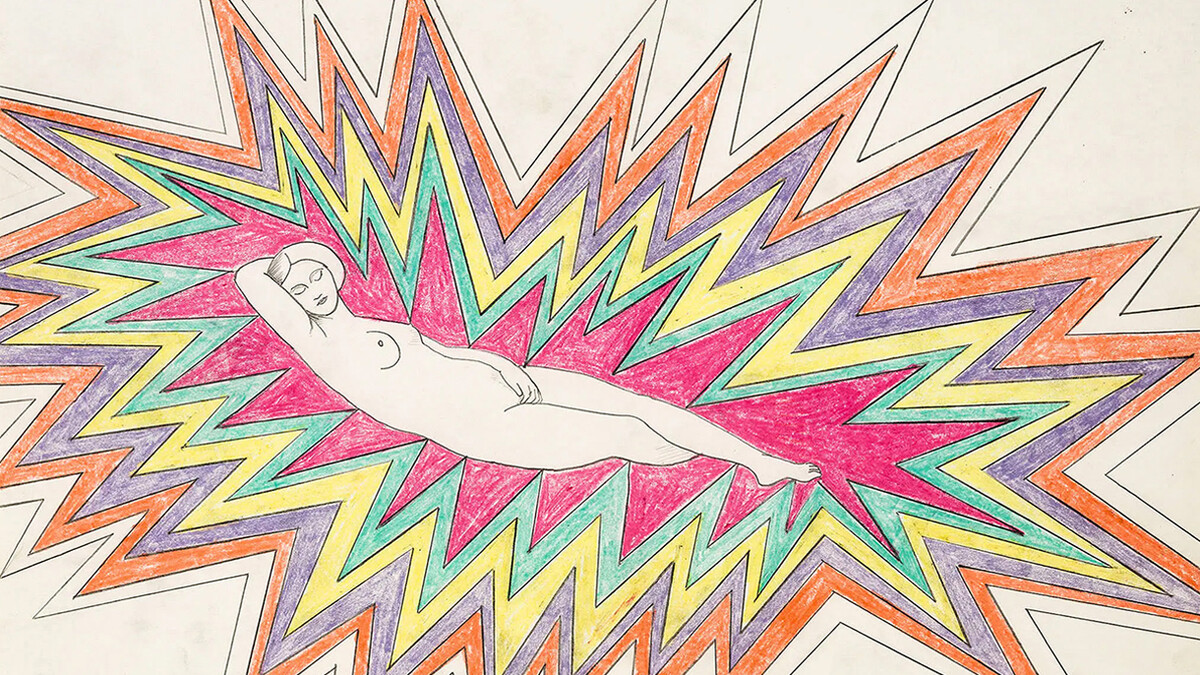
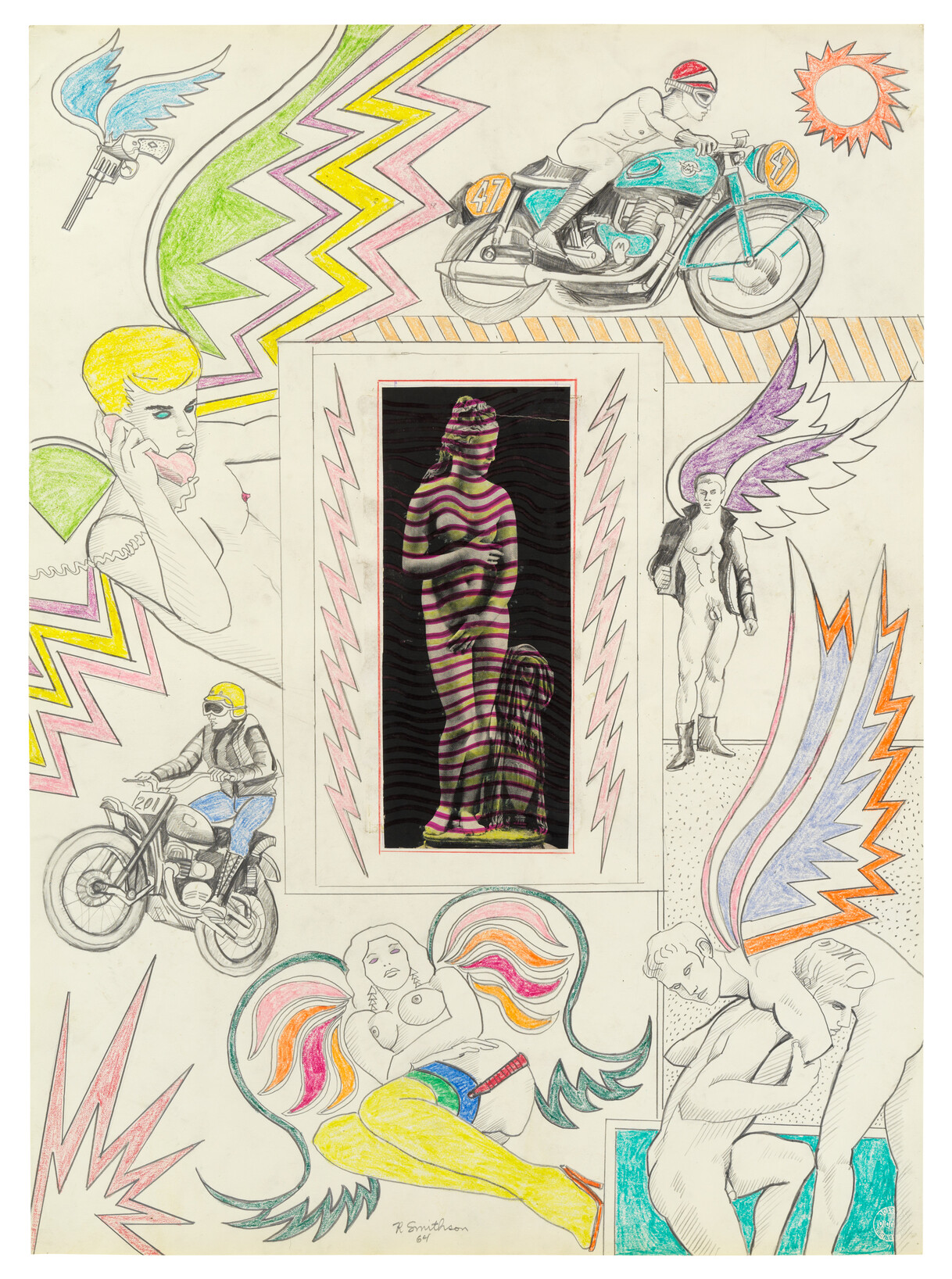

_1968-1.jpg?ixlib=rb-0.3.5&ixid=eyJhcHBfaWQiOjEyMDd9&s=3566466d76117e29ffb4160a639748fb&auto=format&fit=crop&w=1502&q=80)

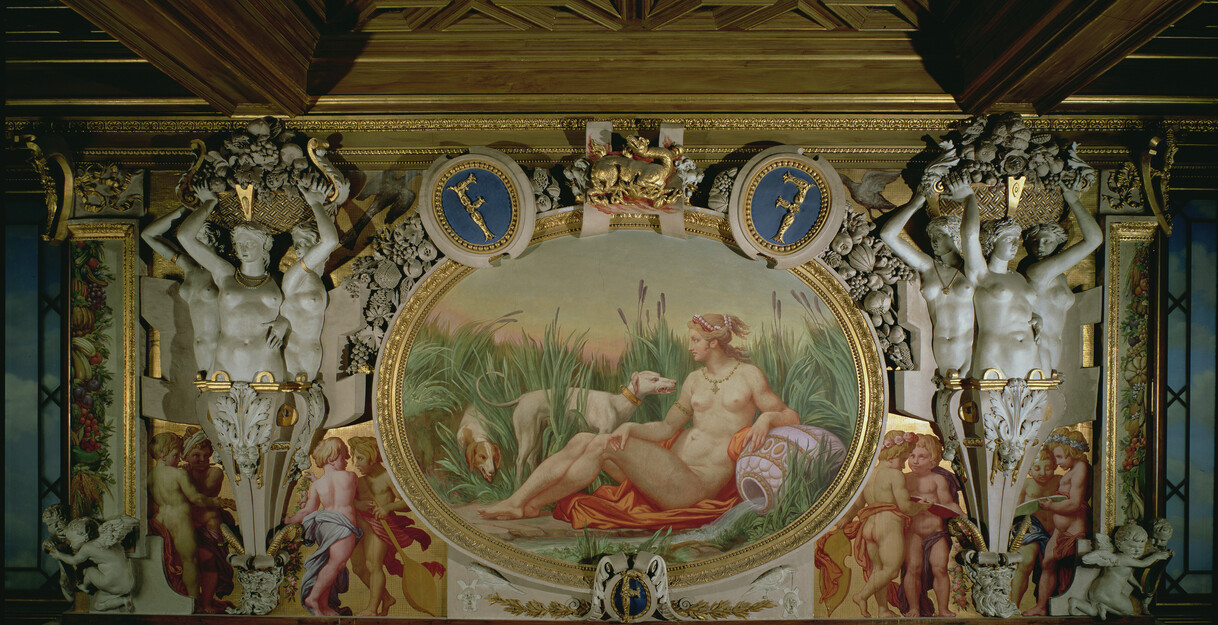
_1964_rs12613.jpg?ixlib=rb-0.3.5&ixid=eyJhcHBfaWQiOjEyMDd9&s=3566466d76117e29ffb4160a639748fb&auto=format&fit=crop&w=1502&q=80)
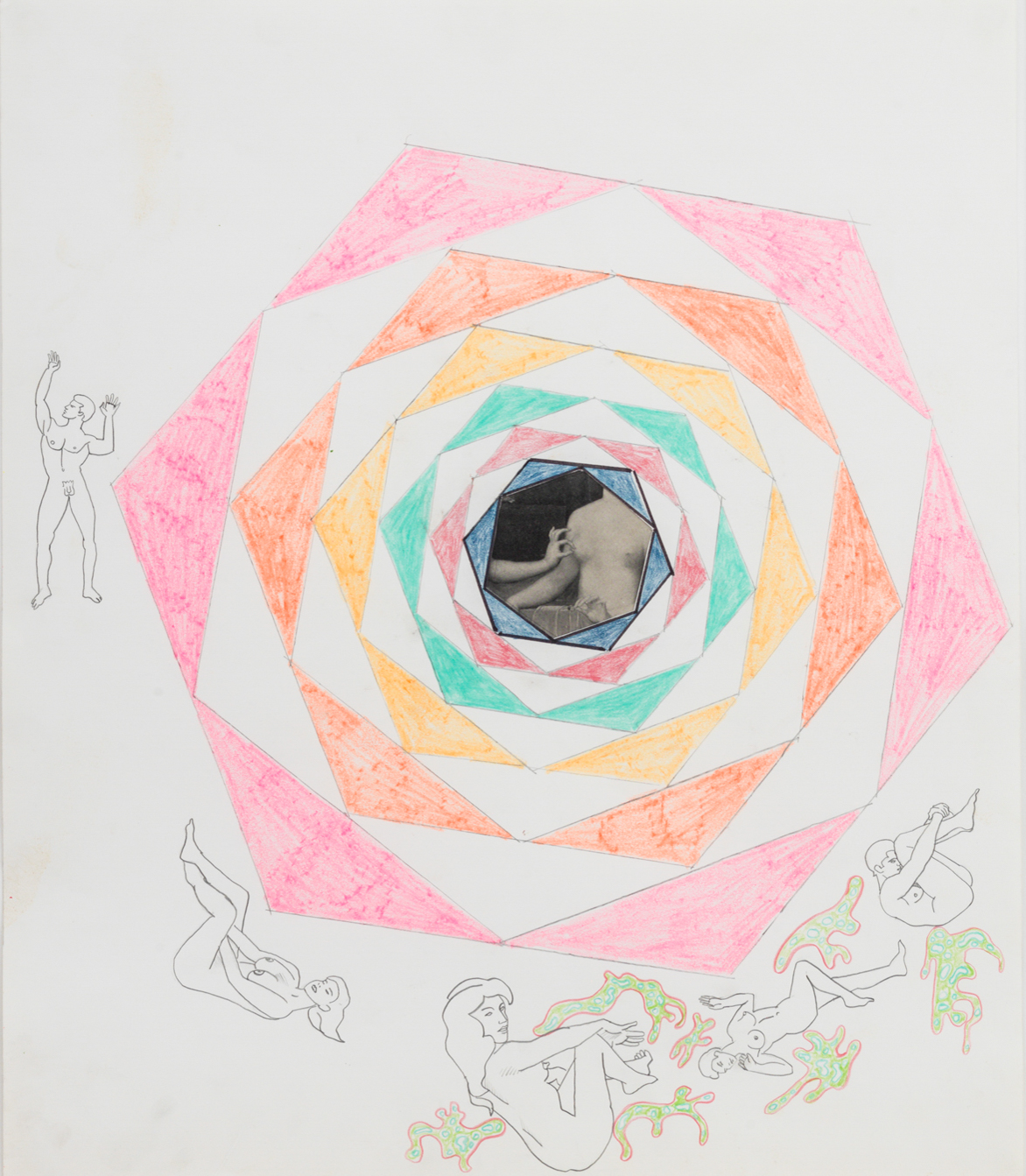
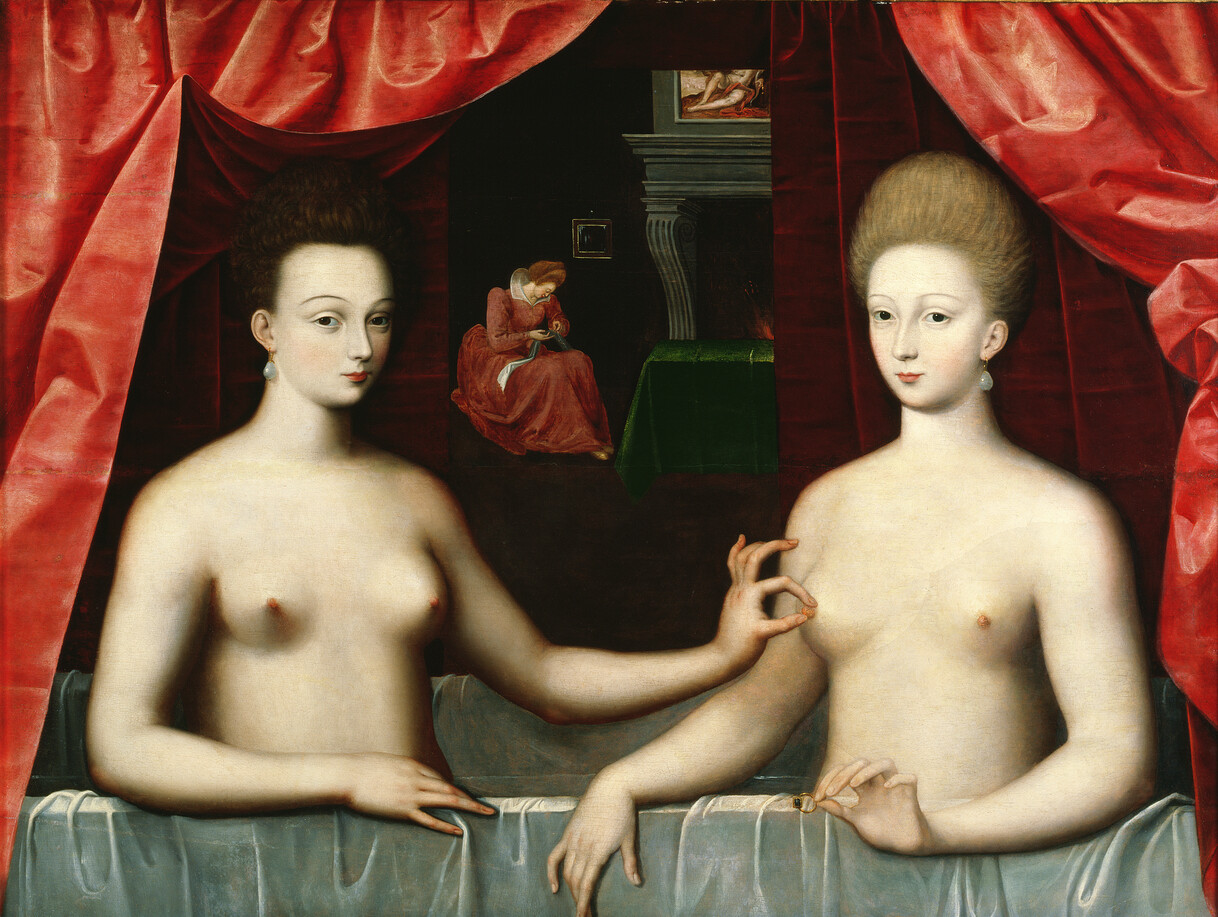
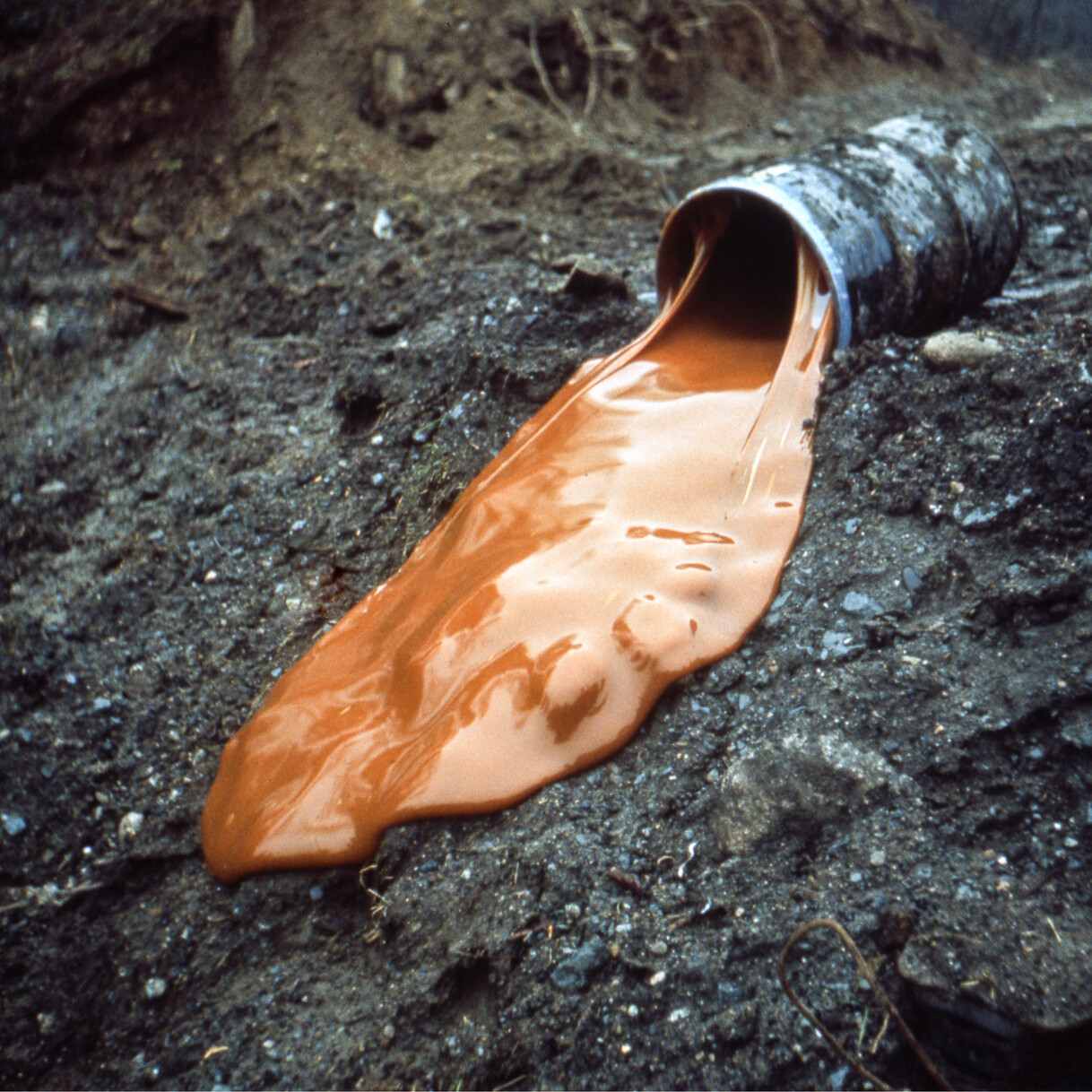


large.jpg?ixlib=rb-0.3.5&ixid=eyJhcHBfaWQiOjEyMDd9&s=3566466d76117e29ffb4160a639748fb&auto=format&fit=crop&w=1502&q=80)

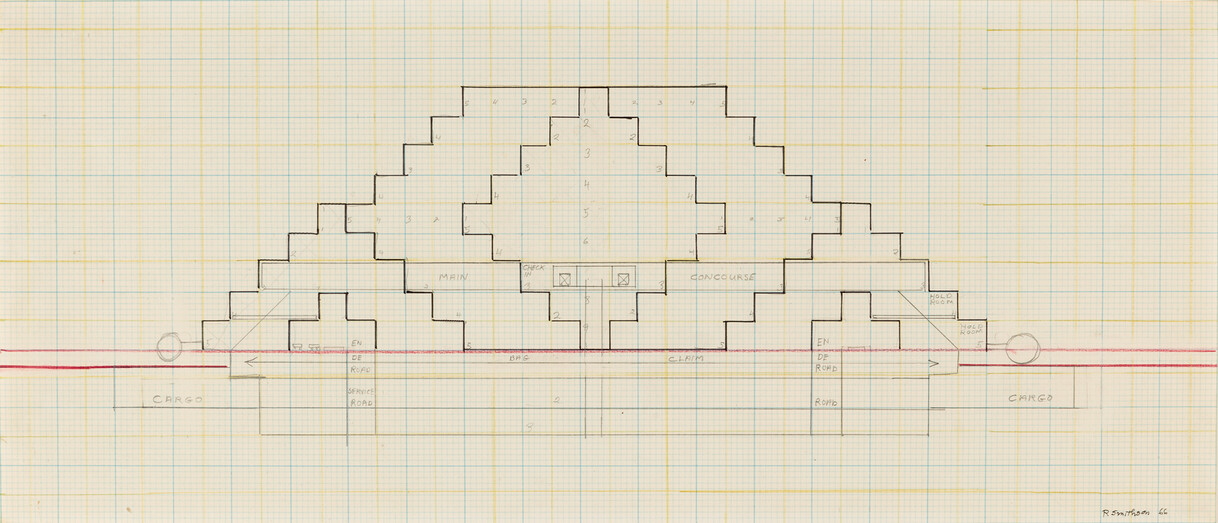
_1963_rs12644.jpg?ixlib=rb-0.3.5&ixid=eyJhcHBfaWQiOjEyMDd9&s=3566466d76117e29ffb4160a639748fb&auto=format&fit=crop&w=1502&q=80)

